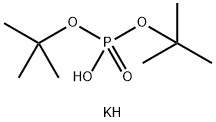Potassium di-tert-butyl phosphate: properties, applications and safety
Nov 16,2023
General Description
Potassium di-tert-butyl phosphate, with its high solubility in polar solvents and strong basic properties, is valuable for diverse applications in organic synthesis, catalysis, and as a phase transfer catalyst. In pharmaceutical applications, it serves as a crucial phosphorylating agent for the preparation of N-phosphonooxymethyl prodrugs, enhancing the bioavailability of active pharmaceutical ingredients. However, safety considerations are important, as the compound can cause skin irritation, serious eye damage, and harm aquatic life. Therefore, prioritizing safety measures and proper disposal methods is essential to mitigate potential risks to human health and the environment. Overall, while offering significant benefits, careful attention to safety is paramount in utilizing Potassium di-tert-butyl phosphate effectively.

Figure 1. Potassium di-tert-butyl phosphate
Properties
Potassium di-tert-butyl phosphate is a chemical compound with the molecular formula C8H20KO4P. This compound exhibits several important properties. Firstly, potassium di-tert-butyl phosphate is highly soluble in polar solvents such as water and alcohols, enabling its use in various solution-based applications. Its solubility makes it a versatile compound for use in organic synthesis, catalysis, and as a phase transfer catalyst. Secondly, it possesses strong basic properties due to the presence of the phosphate anion, which makes it useful in organic reactions as a base catalyst. Additionally, this compound has the potential to facilitate the conversion of various organic substrates. Furthermore, potassium di-tert-butyl phosphate is relatively stable under standard conditions, allowing for ease of handling and storage. In summary, potassium di-tert-butyl phosphate is a valuable compound with high solubility, strong basic properties, and stability, making it useful in a range of chemical and industrial applications. 1
Applications
Potassium di-tert-butyl phosphate is a compound that plays a crucial role in pharmaceutical applications as a phosphorylating agent for the preparation of N-phosphonooxymethyl prodrugs. These prodrugs are specifically designed to enhance the bioavailability of active pharmaceutical ingredients (APIs) by facilitating their conversion inside the body through biocatalytic processes or spontaneous mechanisms such as hydrolysis. By using Potassium di-tert-butyl phosphate in the formulation of prodrugs, the resulting APIs exhibit improved bioavailability, allowing for easier administration as injectables rather than tablets. This enhanced bioavailability not only simplifies drug delivery but also leads to better efficacy and therapeutic outcomes for patients. Moreover, Potassium di-tert-butyl phosphate's high-quality properties and reactivity make it a valuable tool in the synthesis of prodrugs, contributing significantly to advancements in pharmaceutical research and development. Its ability to improve the solubility and stability of APIs further underscores its importance in drug formulation. Overall, the use of potassium di-tert-butyl phosphate in pharmaceutical applications demonstrates its significance in enhancing drug delivery, bioavailability, and ultimately, the effectiveness of pharmaceutical interventions. 2
Safety
Potassium di-tert-butyl phosphate, as a chemical compound, poses various safety considerations that must be carefully addressed. Firstly, it is important to note that this substance can cause skin irritation upon contact. Therefore, proper protective measures such as gloves and lab coats should be worn when handling it to avoid direct skin exposure. Secondly, due to its potential to cause serious eye damage and eye irritation, protective eyewear must be used to prevent any contact with the eyes. In case of accidental exposure, immediate medical attention is necessary to minimize the risk of long-term damage. Furthermore, the substance may cause respiratory irritation, so it should only be handled in well-ventilated areas to reduce the likelihood of inhalation. Additionally, it has been identified as harmful to aquatic life with long-lasting effects. Thus, precautions should be taken to prevent its release into the environment, and proper disposal methods should be strictly adhered to. In summary, when working with Potassium di-tert-butyl phosphate, it is crucial to prioritize safety by implementing appropriate protective measures to mitigate the risks of skin and eye exposure, respiratory irritation, and environmental impact. 3
Reference
1. PubChem. COMPOUND SUMMARY: Potassium di-tert-butyl phosphate. National Library of Medicine, 2005, PubChem CID: 23674467.
2. PRODUCT DATA SHEET: DI-TERT BUTYL POTASSIUM PHOSPHATE. Solvay, CAS 33494-80-3.
3. Potassium di-tert-butyl phosphate. European Chemicals Agency, EC / List no. 619-702-9.
- Related articles
- Related Qustion
- Uses of Potassium di-tert-butylphosphate as the synthetic Intermediate Nov 21, 2019
Potassium di-tert-butylphosphate have a unique activity structure that was commonly used as raw materials and intermediates for pharmaceutical synthesis.
Nicotinamide adenine dinucleotide (NADH) plays a pivotal role in metabolism. Convenient detection NADH its related metabolites has pursuit point-of-care clinical analysis.....
Nov 16,2023APIIbuprofen is the most commonly used and prescribed NSAID. It is a common over-the-counter medication widely used as an analgesic, anti-inflammatory, and antipyretic.....
Nov 16,2023APIPotassium di-tert-butyl phosphate
33494-80-3You may like
Potassium di-tert-butyl phosphate manufacturers
- Potassium di-tert-butylphosphate
-

- $0.00 / 25KG
- 2025-08-19
- CAS:33494-80-3
- Min. Order: 1KG
- Purity: 99%
- Supply Ability: 50000KG/month
- Potassium di-tert-butylphosphate
-

- $10.00 / 1KG
- 2025-06-24
- CAS:33494-80-3
- Min. Order: 1KG
- Purity: 99%
- Supply Ability: 10 mt
- Potassium di-tert-butylphosphate
-

- $0.00 / 1kg
- 2025-04-04
- CAS:33494-80-3
- Min. Order: 1kg
- Purity: 98%
- Supply Ability: 1Ton






